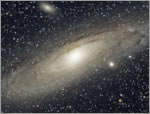 Astronomy podcasts and audio books are a standard part of my commute diet. I can get in about an hour of listening a day on my way to and from work. It’s a great way to stay up-to-date with the latest astrophysical news or to broaden my knowledge of astronomy in general. Check out my links page for some of my favorites. You can also browse iTunes for an extensive list of podcast offerings.
Astronomy podcasts and audio books are a standard part of my commute diet. I can get in about an hour of listening a day on my way to and from work. It’s a great way to stay up-to-date with the latest astrophysical news or to broaden my knowledge of astronomy in general. Check out my links page for some of my favorites. You can also browse iTunes for an extensive list of podcast offerings.
A question often comes to mind as I listen to these programs, such as “When the moon is visible in the daytime sky, why doesn’t the illuminated side appear to be facing the sun?” Usually, the question vanishes from my consciousness as my attention shifts to another topic, such as the lady cutting me off in traffic while texting on her mobile phone with one hand and brushing her hair with the other. The NASA report I was listening to about the recent asteroid that nearly hit the earth seems suddenly ironic, if not immediately foreboding.
Some of the podcasts have a feature of answering listeners’ questions. My favorite–hands down–is Dr. Tim O’Brien’s “Ask an Astronomer” segment on the Jodrell Bank Observatory podcast, the Jodcast. Tim can take a relatively simple question and produce a great mini-lecture on the topic and various tangents. So, I decided to give it a shot and submitted a question that has long dogged me. Here it is:
When viewing an image of a galaxy as seen at an angle, such as the Andromeda Galaxy or even more so with M98, to what extent is the image distorted by the fact that the galaxy is rotating and the light from the far side of the galaxy has traveled many thousands of light years further than the light from the near side? In essence, we should be seeing a lag in the rotation of the far side of the galaxy as compared to the near side. Right? Is this lag long enough to cause a significant distortion in the image?
I am deeply appreciative that Tim chose to answer my question. Here it is:
Note: Tim calculated the distortion as six arcseconds. To get a sense of the angular size of six arcseconds, consider that the angular diameter of the moon is approximately 1920 arcseconds. An arcsecond is about the size of a dime as seen from 1.25 miles (2 kilometers) away. For another interesting perspective on perspectives: if it were bright enough to be seen with the naked eye, the Andromeda Galaxy would appear six times larger than a full moon.
Thanks Tim.
